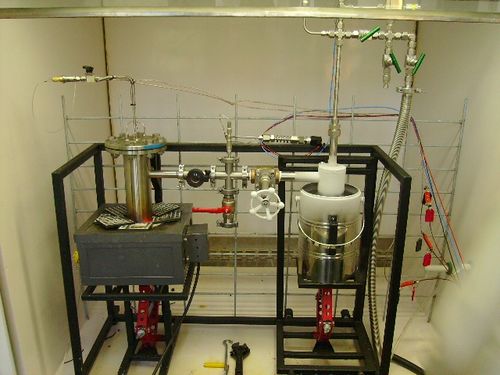Difference between revisions of "Depolymerisation of polytetrafluoroethylene"
(→Introduction) |
|||
| (7 intermediate revisions by 2 users not shown) | |||
| Line 1: | Line 1: | ||
| + | [[File:Depol_apparatus.JPG|500px|thumb|right|Setup used for the pyrolytic depolymerisation of polytetrafluoroethylene.]] | ||
| + | |||
==Introduction== | ==Introduction== | ||
| Line 15: | Line 17: | ||
==Project Contributors== | ==Project Contributors== | ||
* [http://web.up.ac.za/default.asp?ipkCategoryID=4840&sub=1&parentid=2063&subid=2102&ipklookid=7 Prof Philip L. Crouse] | * [http://web.up.ac.za/default.asp?ipkCategoryID=4840&sub=1&parentid=2063&subid=2102&ipklookid=7 Prof Philip L. Crouse] | ||
| − | * Gerard J. Puts | + | * [[Fluoro-materials Science#Students|Gerard J. Puts]] |
| − | * Paul W. Sonnendecker | + | * [[Fluoro-materials Science#Personnel|Paul W. Sonnendecker]] |
==Equipment== | ==Equipment== | ||
==Experimental Procedures== | ==Experimental Procedures== | ||
| − | |||
| − | |||
==Current Projects== | ==Current Projects== | ||
| − | ==Documents== | + | ==Documents, Publications and Contributions to Conferences== |
| + | ===Gerard J. Puts - Pyrolytic Depolymerisation of PTFE=== | ||
| + | Follow these links to the following reports/publications; | ||
| + | * [ftp://ragnarok.up.ac.za/publicftp/lab/Fluoro-materials%20Science/ptfe_depolymerisation/reports_publications/Gerard_Puts_Pyrolitic_Depolymerisation_of_PTFE_1.1_GJP.pdf Gerard J. Puts - CSC 411 Research Project Report] | ||
| + | * [ftp://ragnarok.up.ac.za/publicftp/lab/Fluoro-materials%20Science/ptfe_depolymerisation/reports_publications/PUTS_CROUSE_REDUCED_PRESSURE_PYROLYSIS_1.0_GJP.pdf Gerard J. Puts - CSC 421 Research Project Paper] | ||
| + | * [ftp://ragnarok.up.ac.za/publicftp/lab/Fluoro-materials%20Science/ptfe_depolymerisation/reports_publications/Gerard_Puts_Pyrolitic_Depolymerisation_of_PTFE_1.1_GJP.pdf Gerard J. Puts - CSC 421 Research Project Presentation] | ||
| + | * [ftp://ragnarok.up.ac.za/publicftp/lab/Fluoro-materials%20Science/ptfe_depolymerisation/reports_publications/GJ%20Puts%20Poster.pdf Gerard J. Puts - CSC 421 Research Project Poster] | ||
| + | |||
| + | * [ftp://ragnarok.up.ac.za/publicftp/lab/Fluoro-materials%20Science/ptfe_depolymerisation/reports_publications/Gerard%20Puts%20-%20Navorsingsopsomming.pdf Gerard J. Puts - Suid Afrikaanse Akademie vir Wetenskap en Kuns 2011 Studente Simposium Opsomming] | ||
| + | * [ftp://ragnarok.up.ac.za/publicftp/lab/Fluoro-materials%20Science/ptfe_depolymerisation/reports_publications/Politetrafluoroetileenpirolisie%20onder%20verlaagde%20druk%200.pdf Gerard J. Puts - Suid Afrikaanse Akademie vir Wetenskap en Kuns Studente Simposium 2011 Aanbieding] | ||
Latest revision as of 13:32, 7 December 2011
Contents
Introduction
Polytetrafluoroethylene (also known as Teflon®) is the most common fluoropolymer currently in use, its applications ranging from non-stick coatings in cookware to corrosion resistant pipe linings in the nuclear industry. Any commercial entity wanting to enter the fluoropolymers market usually starts with the production of polytetrafluoroethylene.
The data regarding technical parameters associated with the production of polytetrafluoroethylene is not available in the open literature. The Fluoro-Materials Group is conducting research regarding these parameters, specifically centring on the kinetics of polymerisation for polytetrafluoroethylene.
Tetrafluoroethylene (the monomer of polytetrafluoroethylene) is a colourless, odourless gas at standard conditions. Under pressure tetrafluoroethylene readily undergoes autopolymerisation and in the presence of oxygen it explosively combusts to form peroxides and perfluorides. This property makes it undesirable to store tetrafluoroethylene in large quantities within a confined space and, in such cases, small scale synthesis of the required compound is preferred.
The industrial method for the preparation of tetrafluoroethylene in an energy intensive process that requires the use of dangerous and corrosive materials such as chlorine dioxide and hydrogen fluoride, which makes this method unsuitable for routine laboratory synthesis.
A more convenient method for synthesising tetrafluoroethylene is found in the pyrolitic depolymerisation of polytetrafluoroethylene. This method entails the heating of a quantity of polytetrafluoroethylene to high temperatures under high vacuum conditions. The polymer chains subsequently break down to form radical species which revert to more stable states, forming tetrafluoroethylene.
The reaction conditions must be well controlled as that, under pressures higher than 500 Pa, toxic by-products can form. The most dangerous of these is perfluoroisobutene, which is deadly at parts per billion concentration levels.
Project Contributors
Equipment
Experimental Procedures
Current Projects
Documents, Publications and Contributions to Conferences
Gerard J. Puts - Pyrolytic Depolymerisation of PTFE
Follow these links to the following reports/publications;
